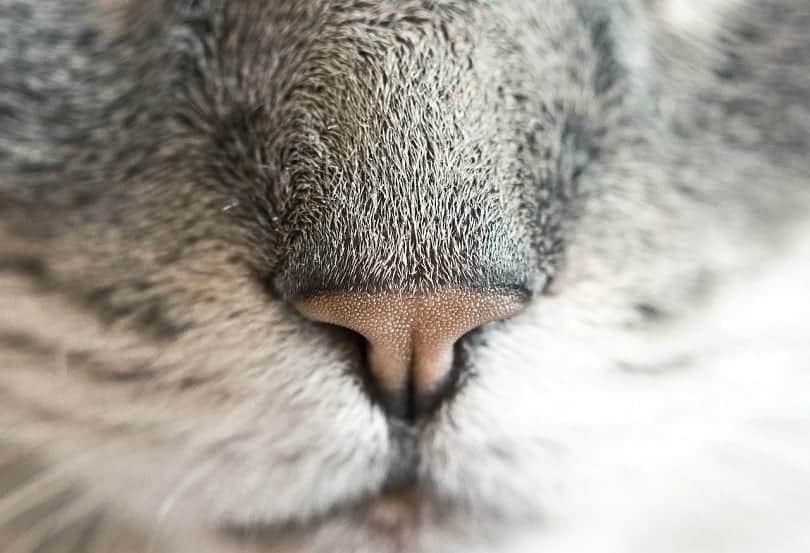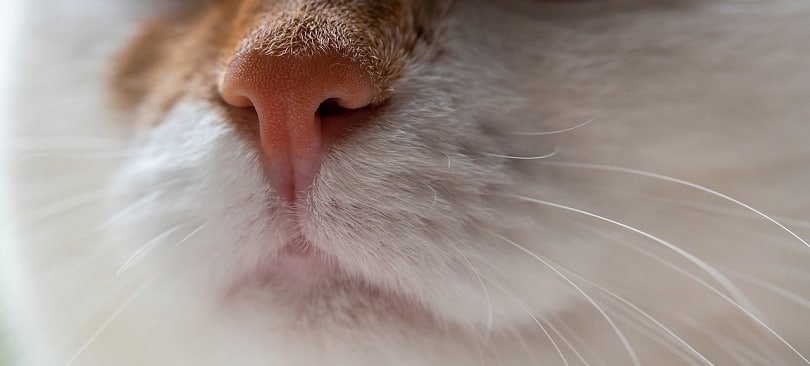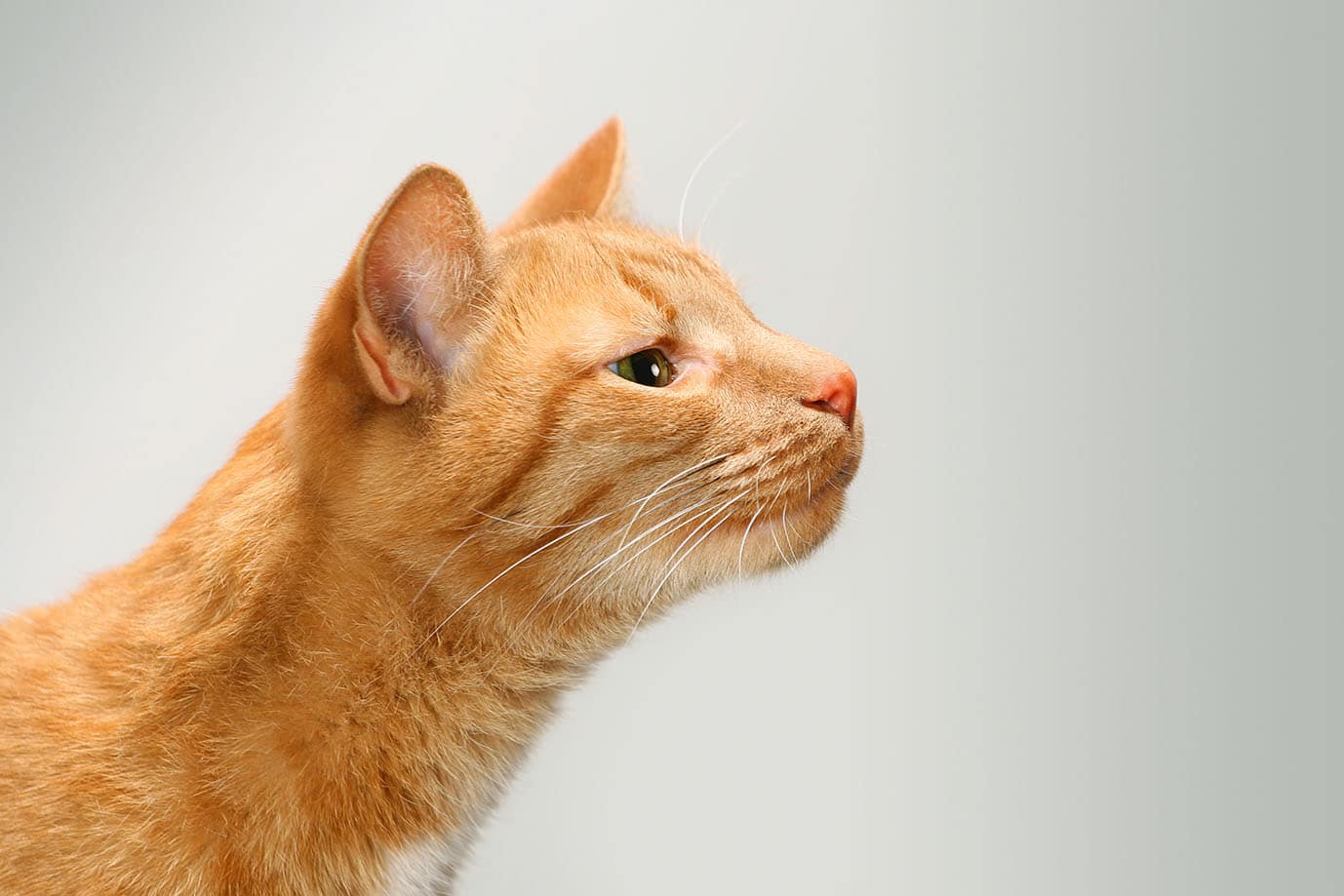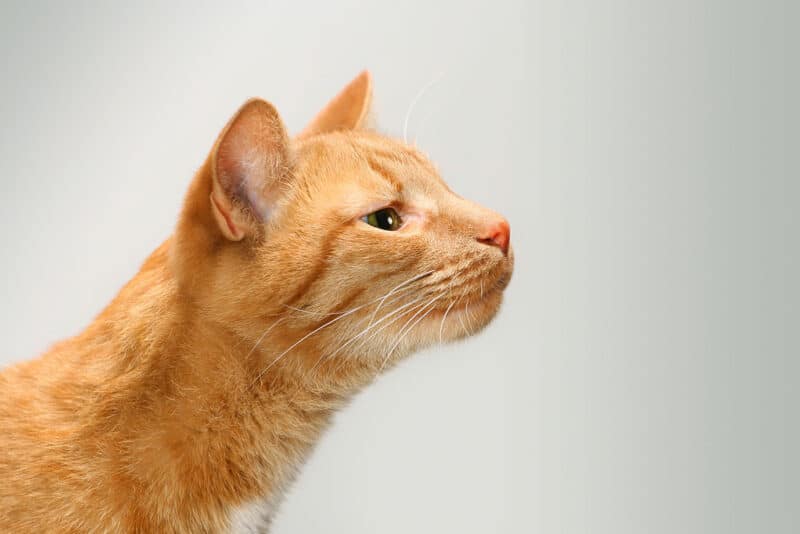A cat’s sense of smell is critical to their survival, and its significance starts from the day they’re born. They are born blind and dependent on their mother. That fact underscores the importance of smell, with several factors affecting the detection distance.
Meteorological elements such as high winds and precipitation or a fan running indoors can affect the cat’s sense of smell. Let’s consider the answer to this question from the cat’s perspective; it is believed that cats may be able to sense smells up to 4 miles!
Continue reading to learn where these numbers come from:

How Smell Stacks Up with a Cat’s Senses
Cats are predators, which affects how they use their senses. They sleep a lot during the day to conserve energy for the night’s hunts. It’s reasonable, considering that their prey is active at this time, too. Rodents and other small animals adapt to this lifestyle to avoid predators.
Felines can see better than people in low-light conditions, which gives them an edge. Surprisingly, they are mid-sighted compared to people, which means they are not great at clearly seeing objects that are either too close to their nose, or too far. For cats, it’s ideal that an object is no more than 20 feet (6 meters) away for them to see it clearly.1 However, they have a wider visual field of 200 degrees compared to our 180 degrees. That means their peripheral vision is better than ours.
Cats score higher when it comes to hearing, too. Their audible range runs from 48 Hz to 85 kHz (48-85,000 HZ) compared to our 20 Hz to 20 kHz (20-20,000 Hz).2 The difference allows felines to hear the sounds that prey species might make under bushes or floorboards.
Their sense of smell is far superior to ours. They have more olfactory receptors, which are specialized receptors located in the nose that detect aromas. The cat’s nose has 45 to 80 (possibly up to 200) million scent receptors, while the human nose contains about 5 million.
Their sense of smell is 14 times better than ours! When you combine these factors, you can appreciate how specialized a feline’s sense of smell is and how it can affect what they detect and from how far away.

Detection and Recognition Thresholds
There are two ways to view smell and taste since the two are so closely related. There is a concentration of molecules when you notice a scent or taste. You know something is there but may not know at first what it is. That’s true if you’ve never encountered it before. Then, there is the recognition threshold. Your brain makes the connection between what it detects and identifies it.
It works the same with cats. It’s an essential factor to consider because it’s often a matter of concentration, which can directly impact how far away a feline can smell something. It’s evident when your pet detects something new. Maybe you’ve visited a friend who has a new cat or dog. Perhaps you’ve walked in the woods or opened a can of food.
Your kitty will likely notice something different as soon as you walk in the door. Your pet will probably take time to smell you and add these scents to their scent database.
The other thing to consider is the sense of smell’s connection with memory. This part of the brain is the most ancient. Cats, like humans, form associations with scents. Think about the first things that come to mind when you smell bread baking in the oven or a cup of hot coffee.
The Other Way Cats Smell
It’s helpful to compare the cat’s sense of smell with ours to understand the distance equation. Felines have another structure to help them understand their world. The vomeronasal organ, or Jacobson’s organ, is located inside the nasal cavity, and extends through the roof of the mouth behind upper incisor teeth. Their function is to pick up pheromones and other undetectable odor molecules in the air.
Pheromones are vital chemical signals for courtship and reproduction. They are also the substances that cats use to mark you as their territory when they rub their cheeks against you.

How Far Away Can Cats Detect Scents?
Getting a precise answer to this question is complicated. A cat won’t tell you they have detected something unless you notice that they act differently while focusing on a new scent. The smell can also be finely tuned out once we’ve identified it and dismissed any danger.
Let’s go back to the scent receptors. Domestic cats have 45 to 80 million of them, or possibly even as high as 200 million. A hound, such as a Beagle, has 225 million. The data for dogs are more widely available than for cats, so we will need to base our answer on assumptions until new data becomes available. It is thought that under perfect conditions canines may be able to pick up scents up to 12 miles (20 km) away. However, we can only guess if cats would have similar capabilities, but there is no actual research to back this claim at the moment.
The vomeronasal organ also has specialized pheromone receptors, and it turns out that cats have an advantage compared to dogs. Cats have around 40 vomeronasal receptor genes, while dogs have less than 10 functional genes. That suggests that felines likely have a wider range of detectable chemical substances.
Anecdotal evidence suggests that dogs and cats can find their way home if they get lost. We often hear about these heartwarming stories. We did manage to find one old study that gave a definitive figure on the distance question. The researcher found that domestic cats could find their way back from a distance of 1.5–4 miles (2.4–6.4 km).
Our research concludes that cats are well-equipped to smell from far distances and at least as good, if not better, than dogs, in detecting certain scents like pheromones. The evidence thus points to numbers as far as 4 miles.
Final Thoughts
The distance from which cats can detect scents in their world is impressive due to their enhanced sense of smell. It’s integral to every aspect of a feline’s existence, from birth to reproduction. Therefore, it makes sense that they have a long detection range. It gives them an evolutionary edge on so many fronts.
Understanding the cat’s talent for detecting scents makes it easier to appreciate how cats navigate their world. Felines are closer to their evolutionary roots than most domesticated animals. That makes their sense of smell so extraordinary and critical.
See Also:
- What Is a Cat Scent Soaker? Here’s What You Need to Know
- Do Cats Like the Scent of Lemon? The Interesting Answer!
Featured Photo Credit: MariyaL, Shutterstock













